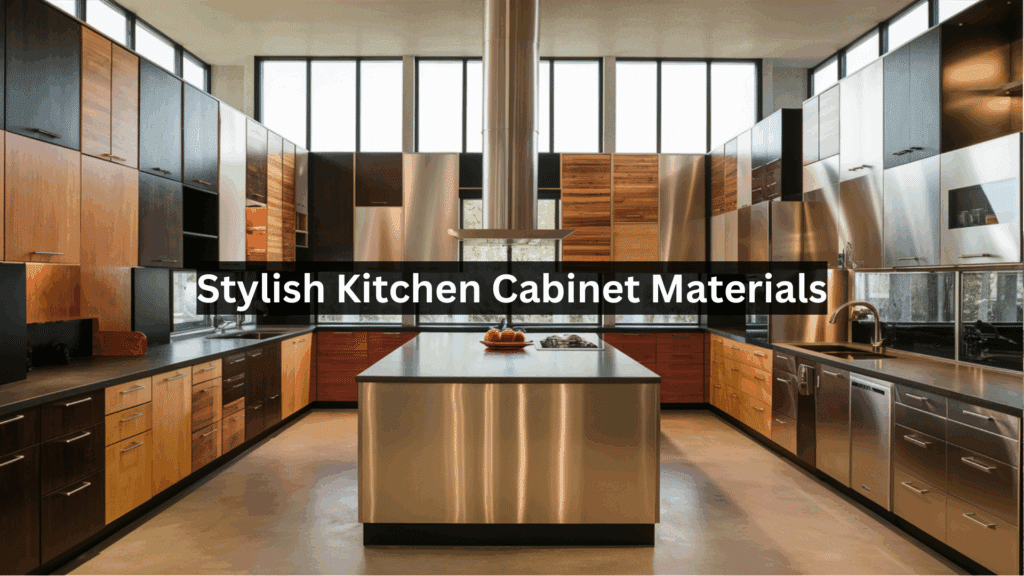The right kitchen cabinets can make a huge difference in the look and feel of your kitchen. Cabinets are more than just storage—they set the style for the entire space. In modern homes, choosing the right materials for your cabinets is essential for both function and design.
In this blog, I’ll share some stylish kitchen cabinet materials that are perfect for modern homes. There are many options, such as sleek finishes, natural wood, and other unique materials.
I’ll walk you through the best choices so you can find the perfect look for your kitchen. Whether you want a clean, minimalist style or something with more warmth, this guide will help you make an informed decision.
Key Factors to Consider When Choosing Cabinet Materials
When selecting kitchen cabinet materials, I focus on several important aspects:
- Durability – How long will the cabinets last with daily use?
- Cost – What’s your budget? Cabinet materials vary widely in price.
- Maintenance – How much time are you willing to spend on upkeep?
- Appearance – What look are you trying to achieve?
- Moisture resistance – Especially important in kitchens with high humidity.
- Weight – Some materials require additional structural support.
Your lifestyle matters, too. Do you have young children? Do you cook frequently? These factors should influence your material choice.
Detailed Breakdown of Kitchen Cabinet Materials
1. Solid Wood
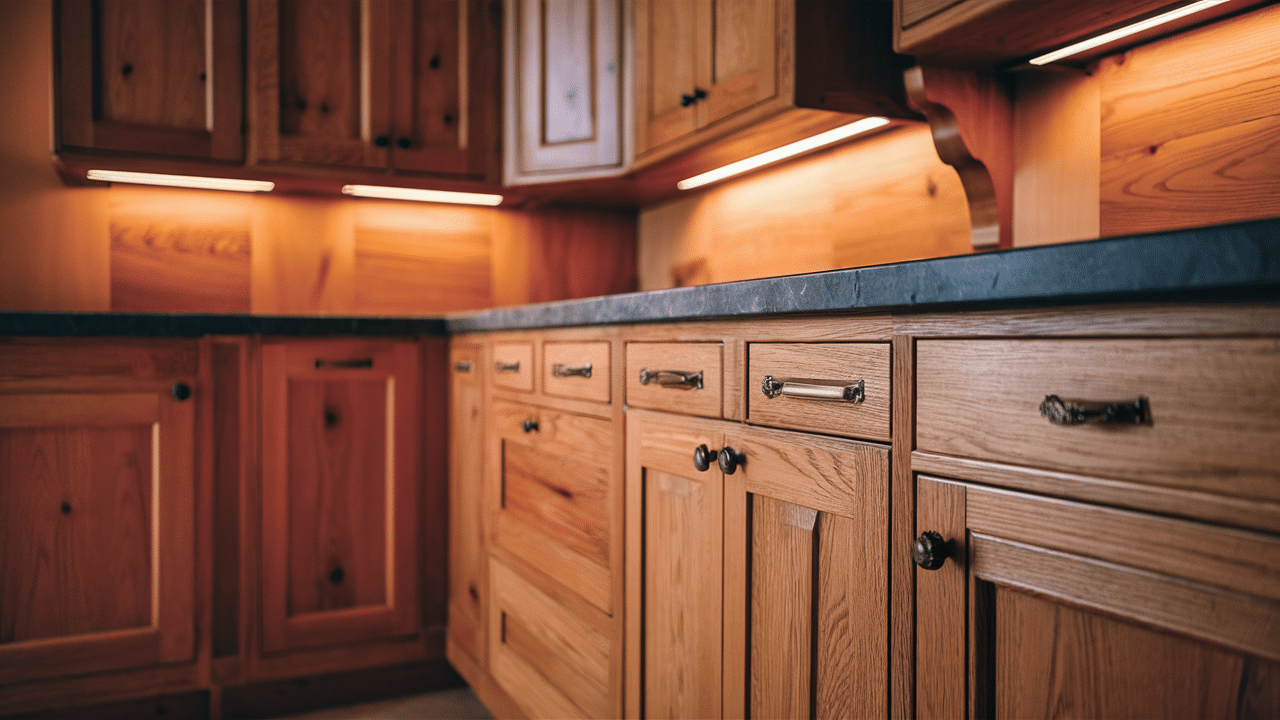
Oak is known for its strength and prominent grain. It resists dents well and has excellent longevity.
Maple offers a smooth, even grain with excellent durability and takes both light and dark stains beautifully.
Cherry darkens beautifully with age, giving a rich, warm appearance that many homeowners prize.
Solid wood brings natural warmth and character to kitchens. It can be stained or painted and repaired when damaged. The look of real wood grain creates a timeless appeal that never goes out of style. Many homeowners choose solid wood for its authenticity and the way it develops character over time.
Pros
Beautiful, unique grain patterns; can be refinished; adds value to your home; extremely long-lasting when properly maintained; available in countless species to match any design style.
Cons
Expensive; can warp with humidity changes; requires regular maintenance; susceptible to scratches and dents; may fade in direct sunlight over time.
2. Plywood
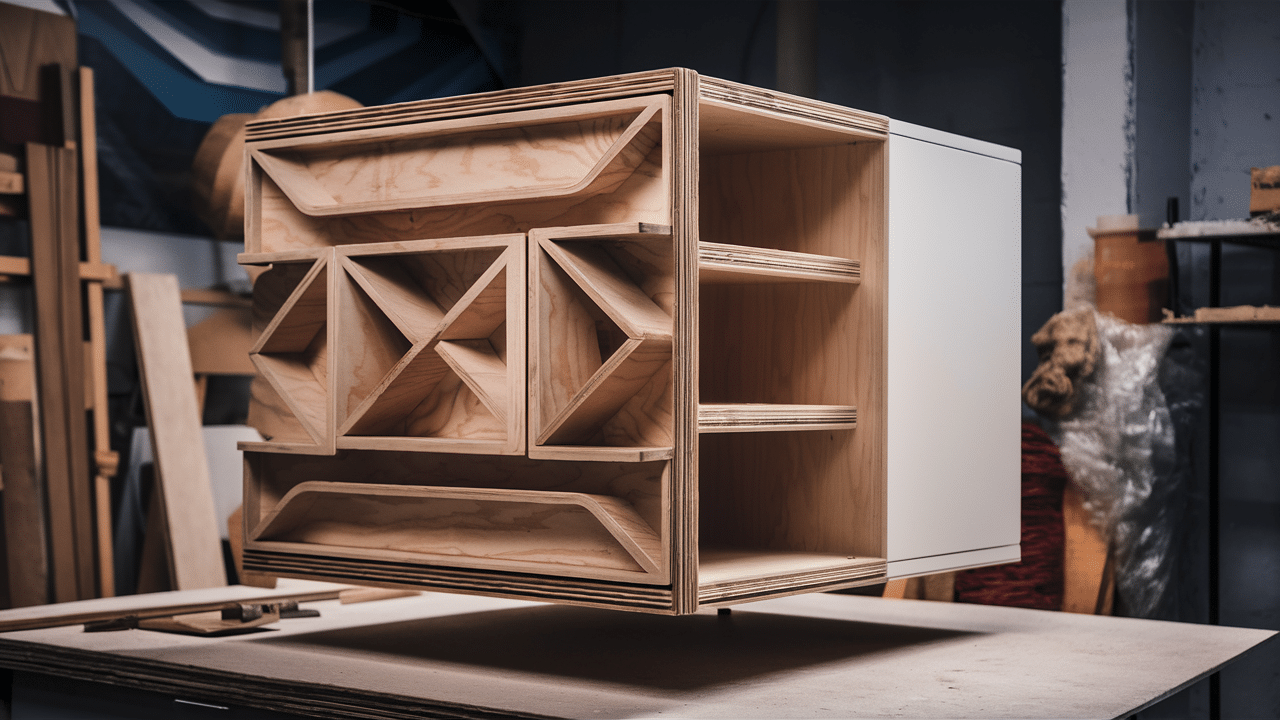
Plywood consists of thin wood layers glued together with the grain direction alternating for stability. This construction makes it resistant to warping and strong enough for cabinet boxes. Quality plywood can last for decades without significant wear or structural issues.
Higher grades of plywood have fewer defects and more layers, improving stability. Cabinet-grade plywood typically has at least 5-7 layers and comes with attractive outer veneers that can be stained or painted.
Many custom cabinet makers prefer plywood for its blend of performance and value.
Pros
Strong, stable, holds screws well, resists water better than many engineered woods; won’t expand and contract like solid wood; maintains its shape over time; available in various thicknesses for different applications.
Cons
More expensive than particle board, visible edges need finishing; lower grades can delaminate over time; quality varies significantly between manufacturers; requires special tools for clean cuts.
3. MDF (Medium-Density Fiberboard)
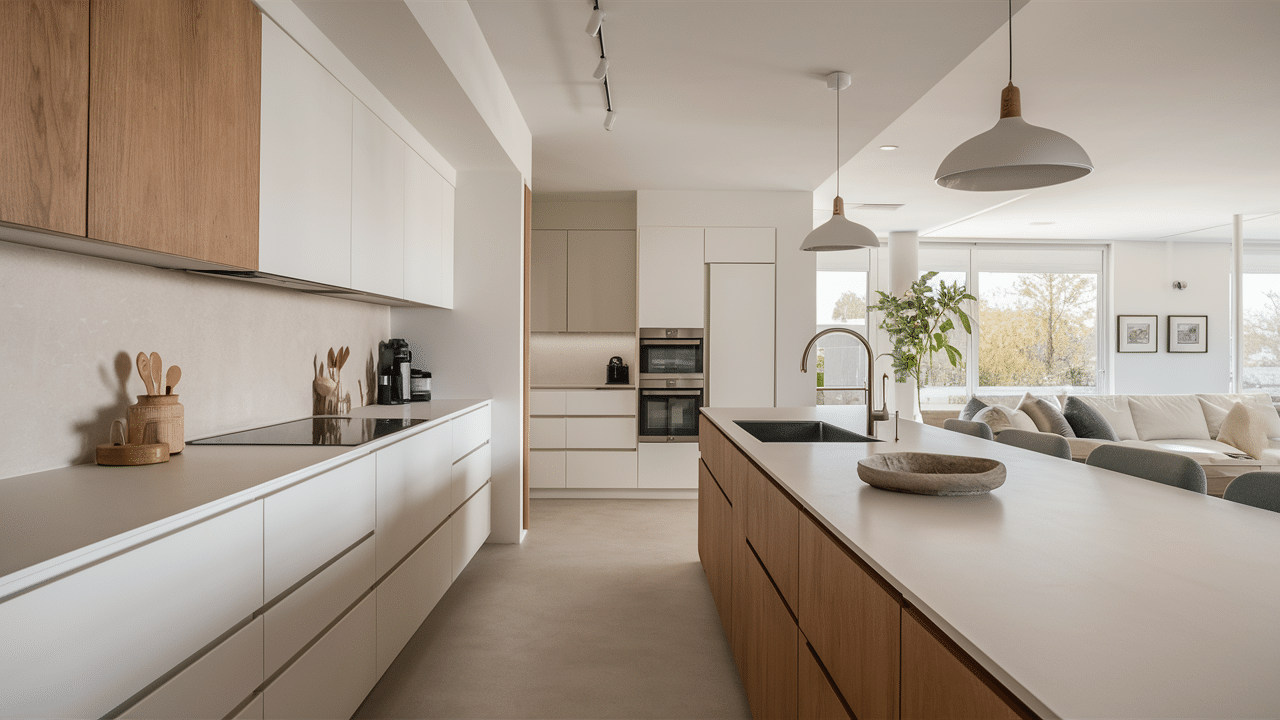
MDF is made from wood fibers and resin pressed into sheets. Its smooth, flat surface makes it perfect for painted finishes because it doesn’t have grain patterns that might show through. The uniform composition eliminates the issues of knots or irregular grain that can appear in natural wood.
I’ve found that MDF works well for cabinet doors, especially shaker styles. Since it’s manufactured without internal stresses, it stays flat and won’t twist like some natural woods might.
For contemporary kitchens with clean lines and solid colors, MDF delivers a flawless look that’s hard to achieve with other materials.
Pros
Smooth finish, consistent density, takes paint well, affordable; no grain means no wood movement issues; perfect for contemporary styles; it comes in moisture-resistant versions for wet areas; excellent for intricate router work and detailed edges.
Cons
Heavy, doesn’t hold screws as well as solid wood, can swell when wet; difficult to repair if damaged; not ideal for staining; requires special screws or reinforcement at hinge points; produces harmful dust when cut.
4. Particle Board
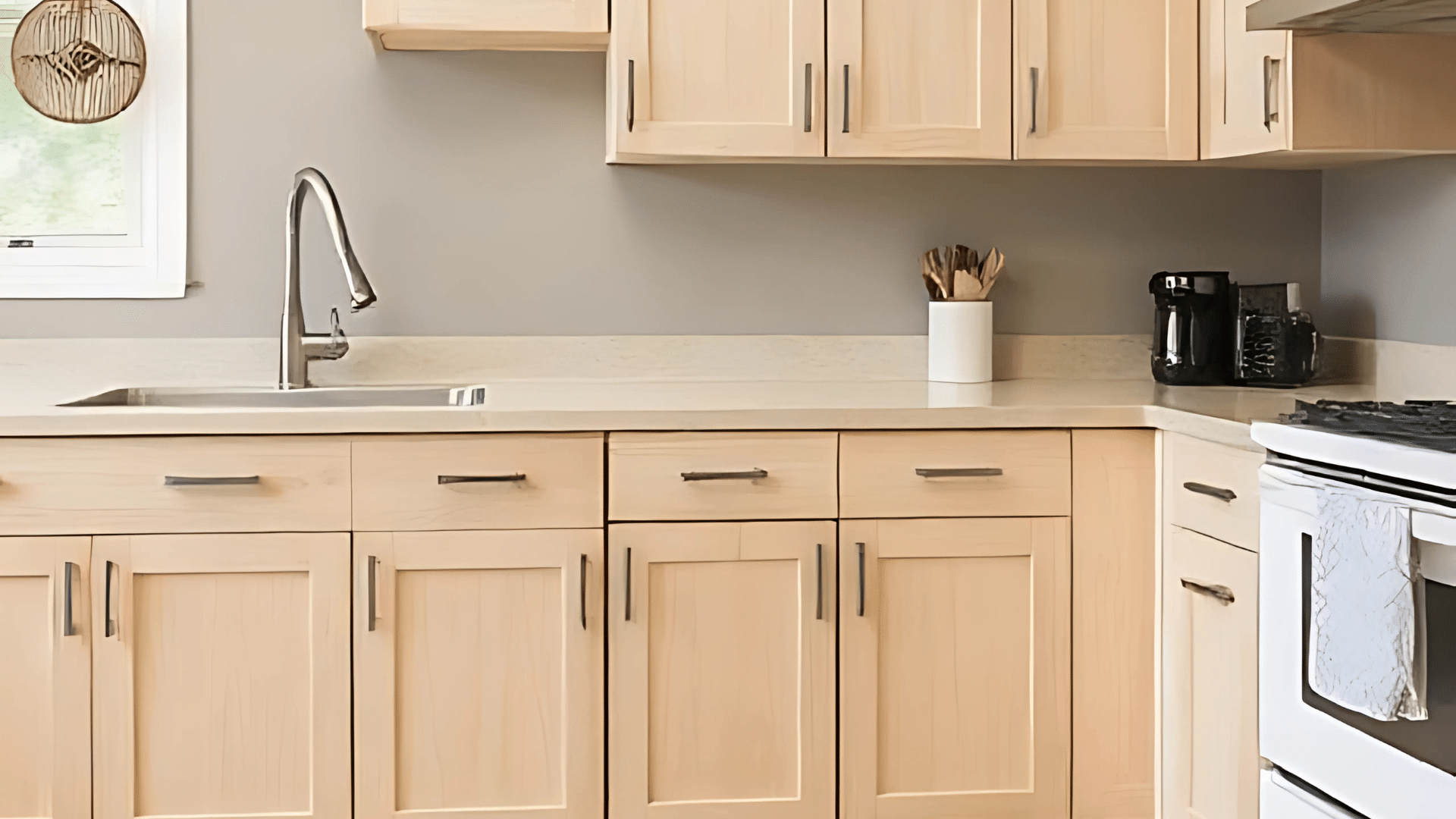
Particle board is a budget option for cabinet construction made from wood chips and sawdust bonded with adhesive. It’s manufactured by compressing wood particles with resins and then baking them to create sheets of various thicknesses.
Many ready-to-assemble (RTA) and budget cabinet lines use particleboard cores with decorative overlays. When properly sealed on all sides and used in dry environments, particleboard can perform adequately for many years.
For rental properties or temporary kitchens, it offers a cost-effective solution that looks good initially.
Pros
It is very affordable, consistent, doesn’t expand or contract much, is uniform throughout without weak spots, is readily available, takes laminate and veneer well, and is good for short-term installations or rental properties.
Cons
Lower strength, poor moisture resistance, can sag under heavy items, shorter lifespan; screws can strip out easily; difficult to repair once damaged; significantly heavier than plywood; tends to deteriorate quickly if exposed to moisture.
5. Melamine
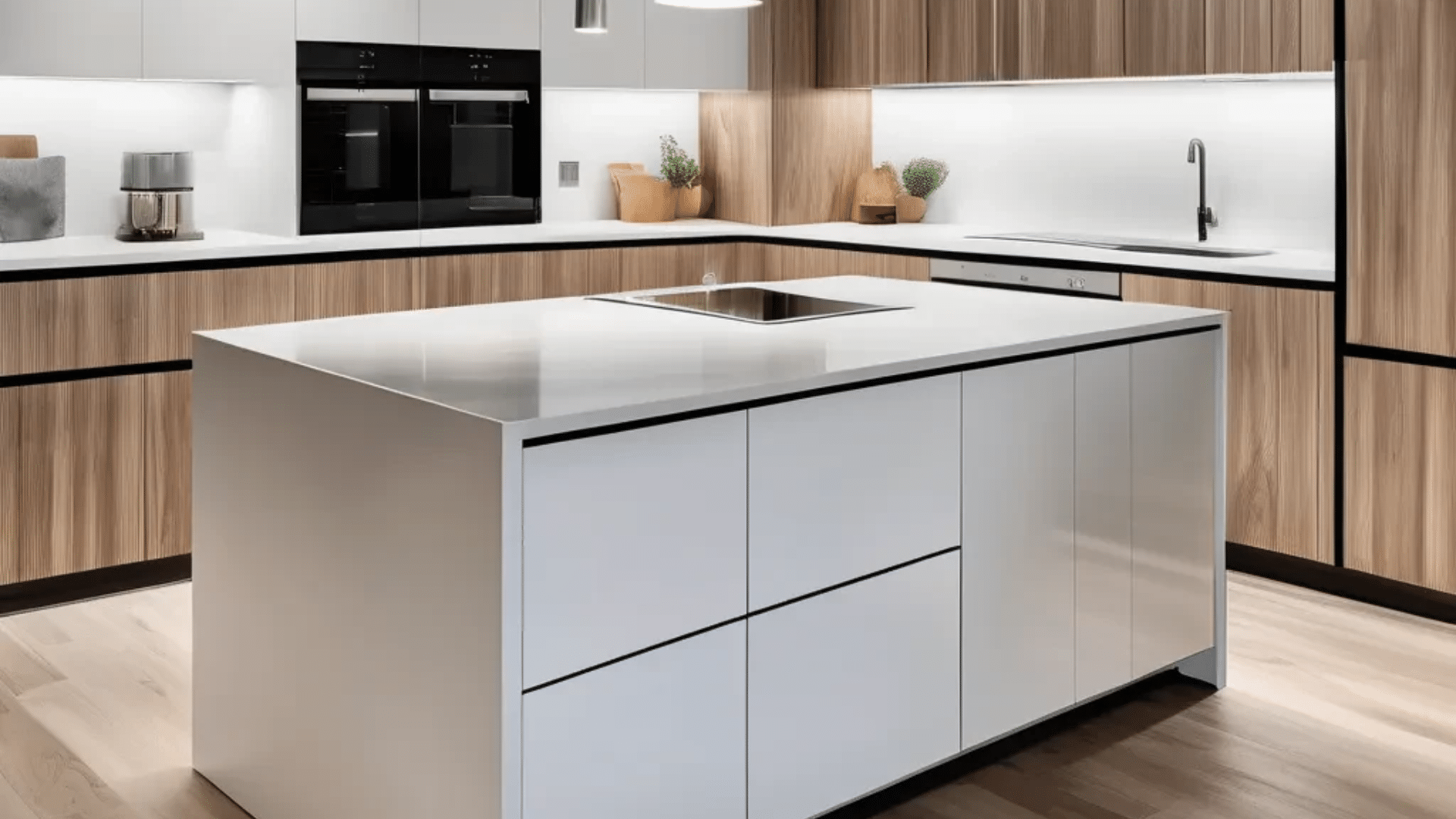
Melamine is a resin coating applied to a substrate (usually particle board). It comes in many colors and patterns, from solid colors to wood-grain simulations. The melamine layer is thermally fused to the substrate under high pressure, creating a hard, sealed surface.
This material is common in commercial settings and modern kitchens because of its clean look and practicality. The surface is non-porous, making it highly resistant to stains from coffee, wine, or cooking oils.
For busy families who need low-maintenance options, melamine provides good value with minimal upkeep requirements.
Pros
It is scratch-resistant, easy to clean, affordable, and doesn’t fade. It resists most household chemicals, is available in hundreds of colors and patterns, won’t absorb odors, is ideal for contemporary designs, and has a consistent color throughout production runs.
Cons
Chips easily at edges, difficult to repair, limited design options; feels less premium than natural materials; edges must be banded for protection; visible seams where pieces meet; tends to look dated faster than natural materials.
6. Thermofoil
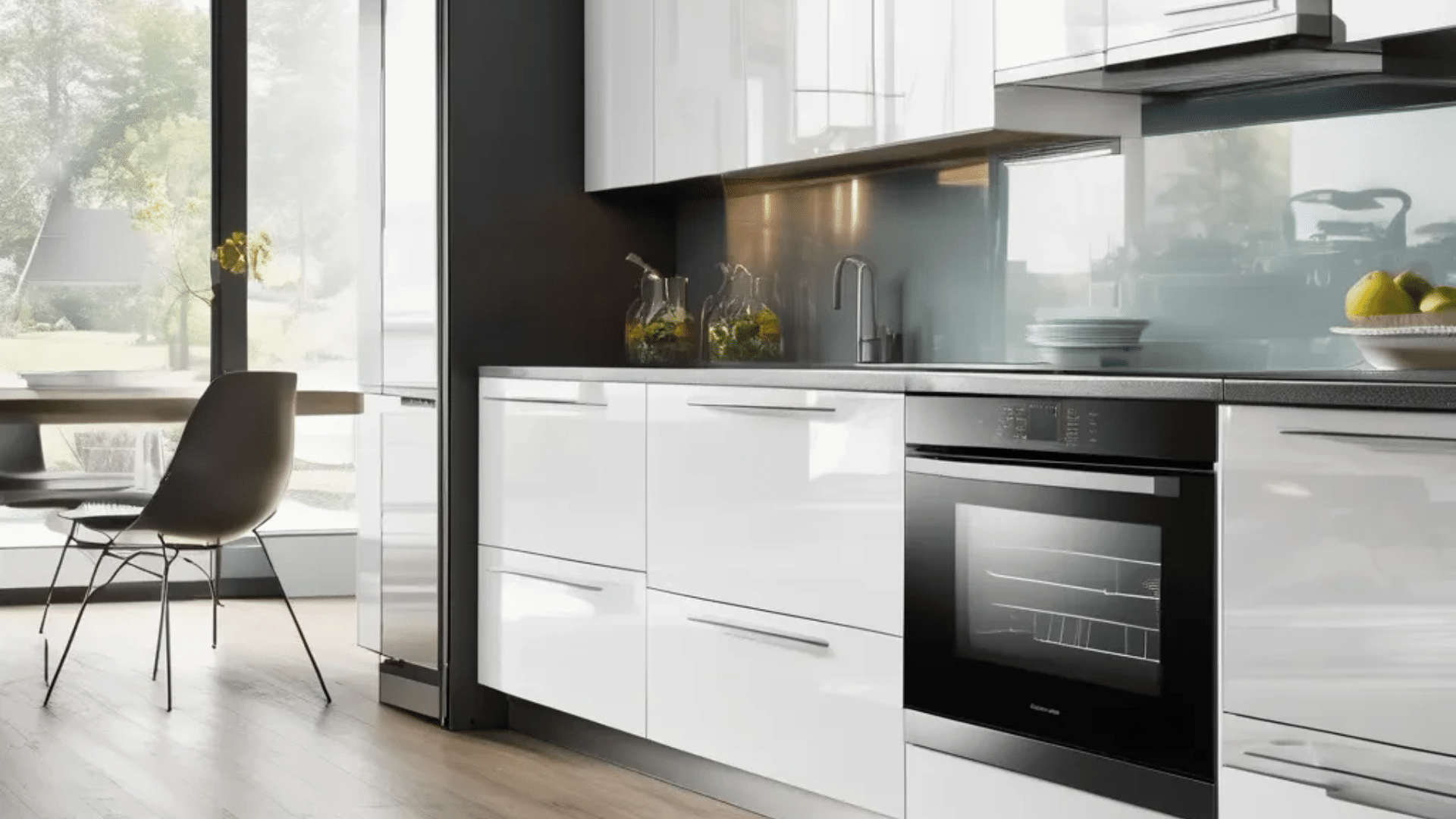
This vinyl coating is heated and pressured onto MDF, creating a seamless surface. White thermofoil cabinets are common in many kitchens. The material wraps around edges and details, eliminating the need for edge banding and creating a seamless appearance.
Thermofoil offers the clean, crisp look of painted cabinets without brush marks or imperfections. The manufacturing process ensures consistent color and texture across all cabinet components.
For homeowners who like the look of painted cabinets but worry about chipping, thermofoil provides a durable alternative at a lower price point.
Pros
Affordable, smooth finish, easy to clean, moisture-resistant; no paint cracking at joints; uniform color and finish; available in matte, satin, and glossy finishes; perfect for contemporary and transitional kitchen styles; resistant to stains and fading.
Cons
Can peel near heat sources, difficult to repair, limited color options; can’t be refinished when damaged; quality varies greatly between manufacturers; susceptible to delamination in humid environments; heat shields required near dishwashers and ovens.
7. Laminate
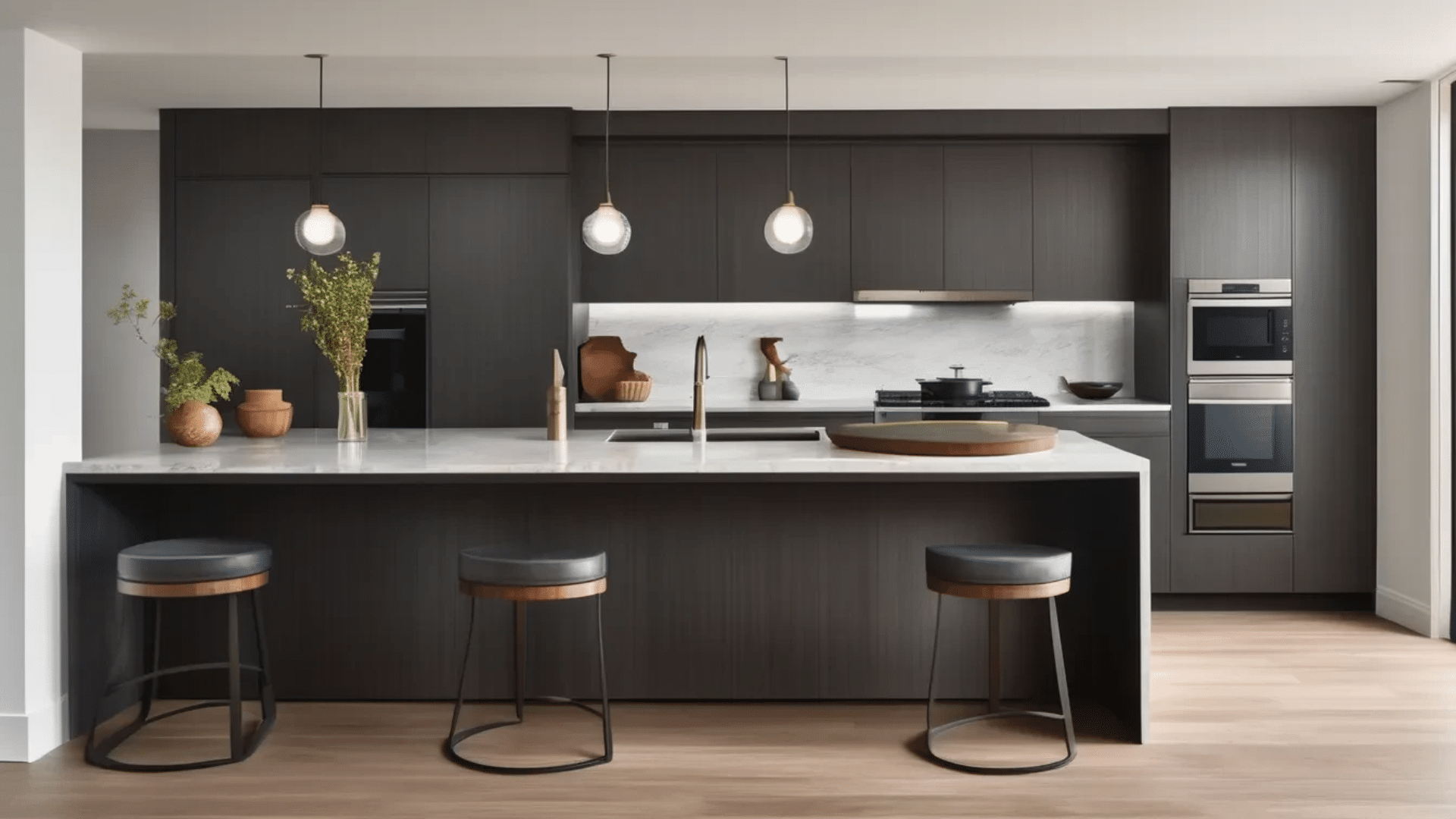
Laminate consists of paper layers impregnated with resin. High-pressure laminates (HPL) are thicker and more durable than low-pressure versions. The material is bonded to a substrate like particle board or MDF to create cabinet doors and drawer fronts.
Modern laminates can mimic stone, wood, or metal surprisingly well. Technology has advanced to create textured surfaces that not only look like natural materials but also feel like them.
Some premium laminates feature synchronized textures where the surface indentations match the printed pattern, creating an incredibly realistic effect.
Pros
It is very durable, stain-resistant, and available in a wide range of colors and patterns. It is affordable, withstands heavy use, is resistant to impact, scratches, and most household chemicals, doesn’t fade even in direct sunlight, is excellent for busy family kitchens, and requires virtually no maintenance.
Cons
Can chip at edges, difficult to repair, visible seams; lacks the prestige of natural materials; cannot be refinished; lower-quality laminates can look artificial; edges require special treatment to prevent peeling; heat resistance varies by manufacturer.
8. Stainless Steel
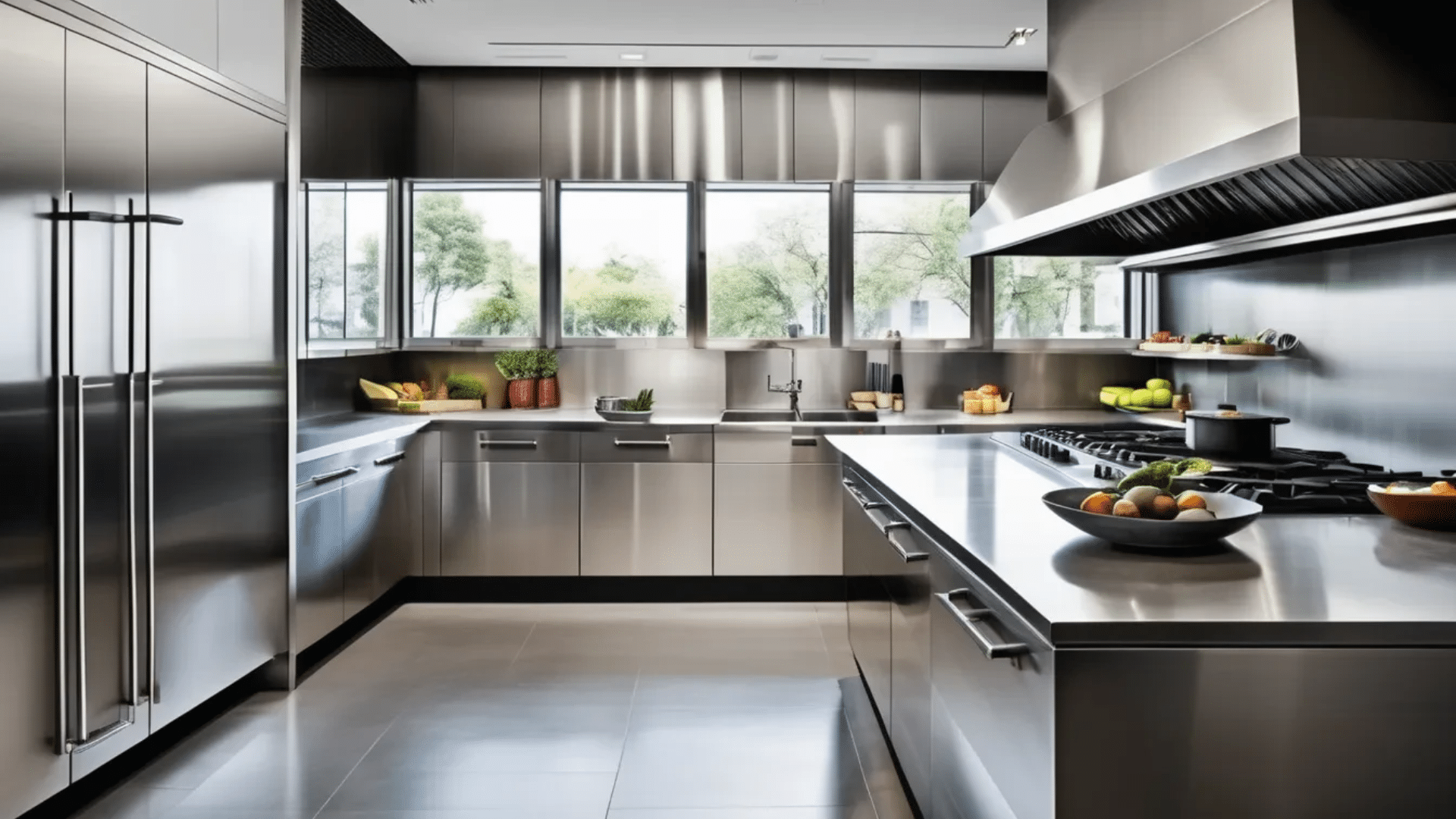
Popular in professional kitchens, stainless steel cabinets bring an industrial look to home kitchens. Available in different finishes from mirror-polished to brushed, stainless steel cabinets make a bold statement while offering unmatched durability.
Unlike organic materials, stainless steel won’t harbor bacteria, making it ideal for health-conscious households. It also stands up to extreme temperatures, moisture, and most chemicals without degrading.
Many professional chefs bring this material into their home kitchens because it provides worry-free performance even under the most demanding cooking conditions.
Pros
Very hygienic, heat-resistant, water-resistant, long-lasting; won’t absorb odors or harbor bacteria; completely impervious to water damage; won’t off-gas or contribute to indoor air pollution; resistant to staining; 100% recyclable for eco-conscious homeowners.
Cons
Shows fingerprints, can dent, noisy, cold appearance without other materials to balance; expensive compared to many alternatives; requires special cleaners to maintain appearance; conducts heat and cold; can scratch despite its durability; limited style options.
9. Acrylic
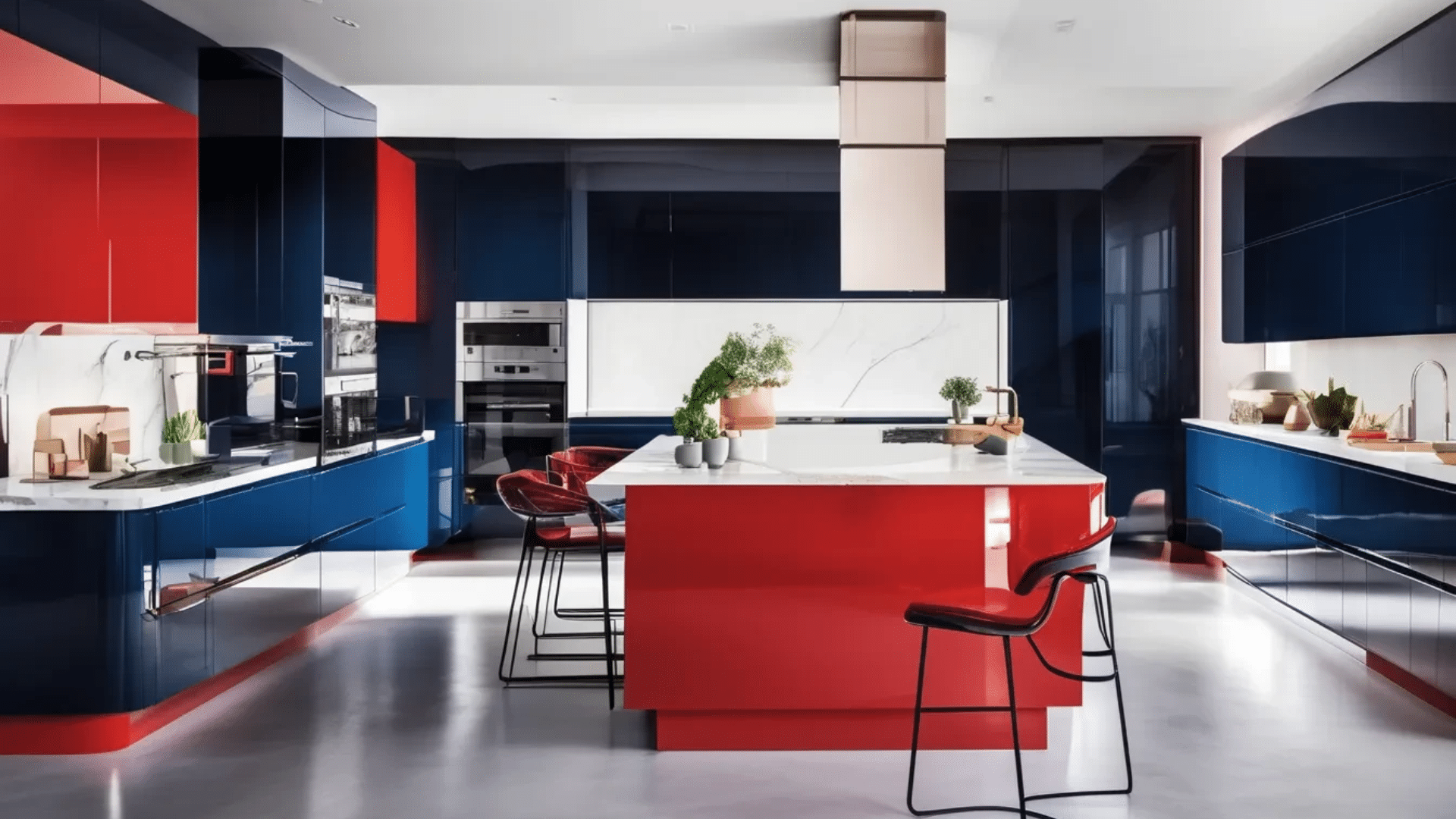
Acrylic cabinets feature a mirror-like, high-gloss finish that reflects light, making spaces feel larger. The color runs throughout the material rather than being applied as a coating, resulting in vibrant, consistent colors that won’t fade or peel over time.
Modern, high-end European kitchens often showcase acrylic cabinets for their sleek, minimalist appeal. The non-porous surface prevents bacteria growth and makes cleaning effortless.
For small kitchens or spaces with limited natural light, acrylic’s reflective properties can dramatically change the perceived spaciousness and brightness of the room.
Pros
Ultra-modern look, UV-resistant (won’t yellow), easy to clean, scratch-resistant; creates a sense of spaciousness through light reflection; exceptionally smooth surface with no visible texture; resistant to water and humidity; many manufacturers offer touch-up kits for minor damage; available in vibrant, saturated colors not possible with other materials.
Cons
Expensive, shows fingerprints, limited color selection; requires special cleaning products to maintain the glossy finish; can develop micro-scratches over time; edges must be perfectly finished to maintain the premium look; sensitive to certain chemicals and abrasive cleaners.
10. Glass-Front Panels
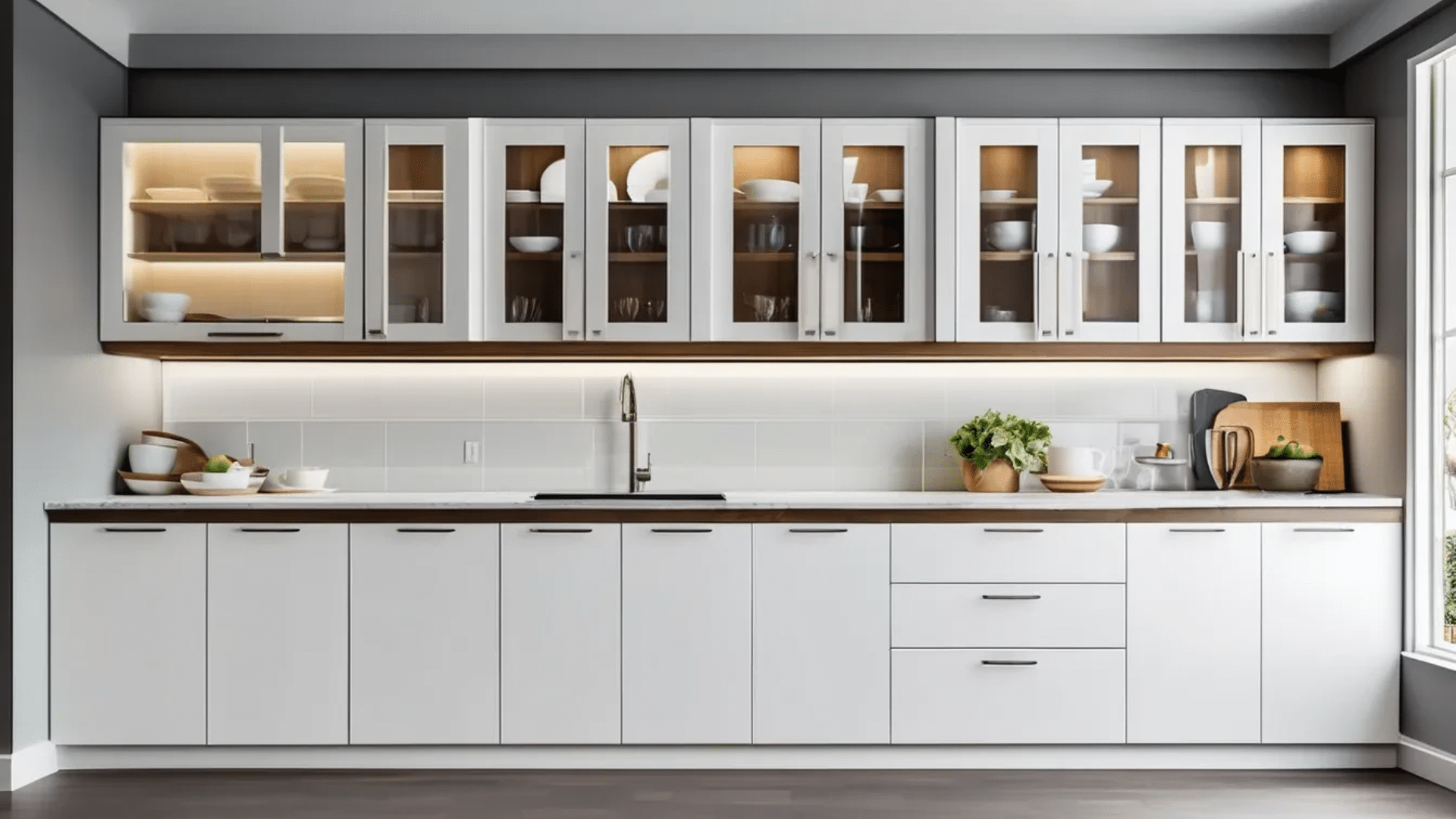
Glass panels in cabinet doors create visual interest and let you display attractive items. Available options include clear, frosted, seeded, textured, and stained glass to suit different design styles and privacy needs.
Glass-front cabinets break up the monotony of solid cabinet fronts and can serve as a focal point in the kitchen. When strategically lit from inside, they create ambient lighting that adds warmth and dimension to the space.
Many designers recommend limiting glass fronts to upper cabinets containing attractive dishware or collectibles while using solid doors for lower cabinets that store less display-worthy items.
Pros
Opens up space visually, allows for lighting inside cabinets, easy to clean; creates display opportunities for decorative items; adds depth and dimension to kitchen design; can be changed without replacing entire cabinets; allows light to penetrate through cabinets; creates a transition between solid elements.
Cons
Contents are visible (requires organization), breakable, more expensive; requires more frequent cleaning of both the glass and cabinet interiors; limits storage of less attractive items; some types may look dated as trends change; adds complexity to cabinet construction; requires special hardware for secure attachment.
11. Bamboo
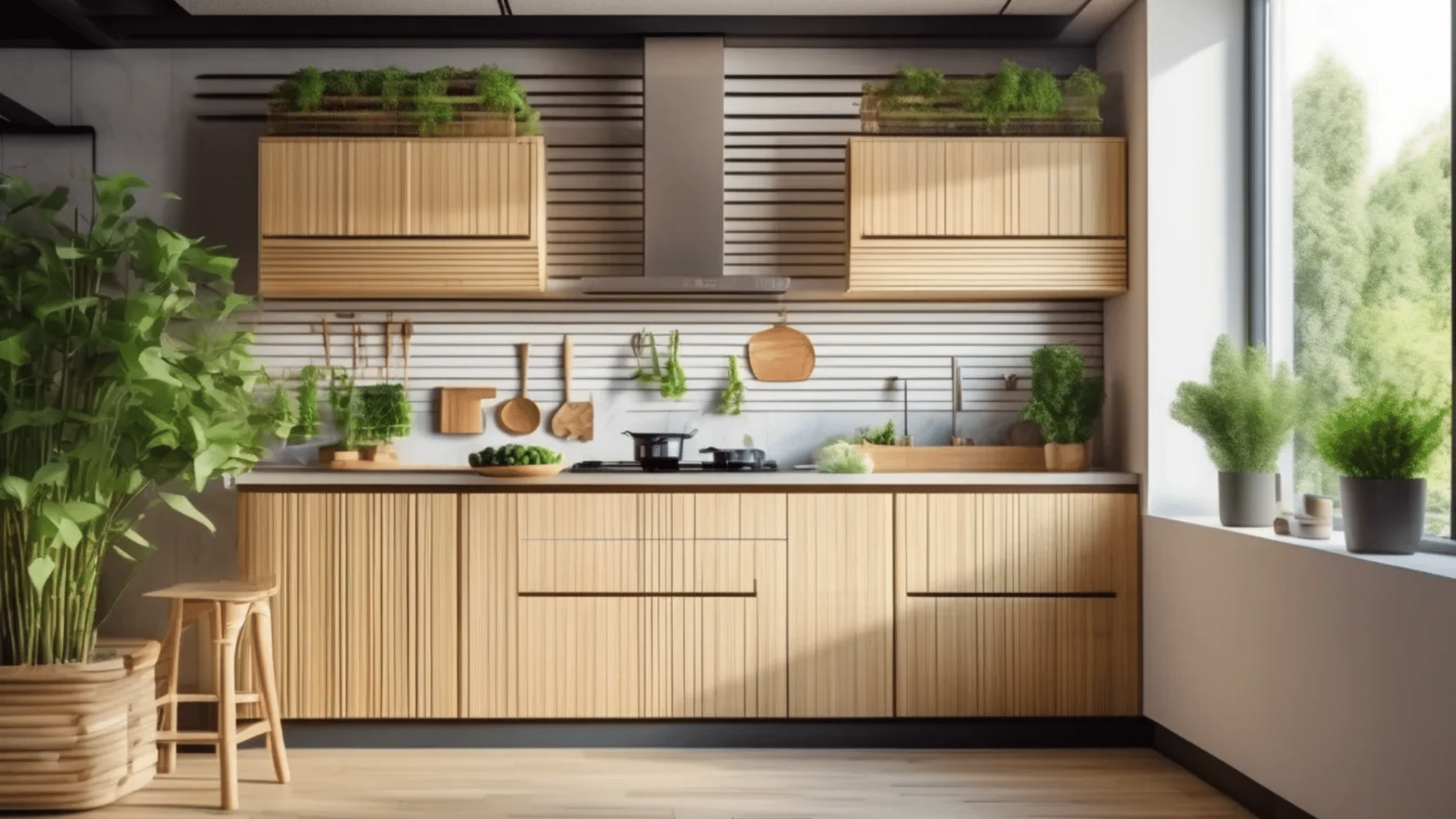
As a fast-growing grass, bamboo is an environmentally friendly choice that offers a distinctive look. It reaches maturity in just 3-5 years (compared to 20+ years for hardwoods), making it one of the most renewable cabinet materials available.
Bamboo’s natural light honey color brightens kitchens and pairs well with both contemporary and Asian-inspired designs. The material is actually harder than many traditional hardwoods, scoring higher on the Janka hardness scale than maple or oak.
For eco-conscious homeowners who don’t want to sacrifice quality or aesthetics, bamboo provides an attractive compromise between sustainability and performance.
Pros
Sustainable, naturally water-resistant, unique appearance; extremely hard and durable; grows without pesticides or fertilizers; requires less energy to harvest and process than hardwoods; resistant to swelling and shrinking; antimicrobial properties inhibit bacterial growth.
Cons
Limited color options, can be costly, may scratch easily, darkens with age and exposure to sunlight, quality varies widely between manufacturers, some adhesives used in processing may contain formaldehyde, specialized knowledge required for installation, limited availability compared to traditional woods.
12. PVC (Polyvinyl Chloride)

PVC cabinets are completely waterproof, making them suitable for humid environments. This synthetic material doesn’t absorb moisture at all, eliminating concerns about swelling, mold, or mildew that can plague other cabinet materials in high-humidity areas.
Popular in coastal regions and tropical climates, PVC cabinets maintain their appearance and structural integrity even when exposed to salt air and extreme humidity.
The material is also highly resistant to chemicals, making it appropriate for utility rooms and garages where exposure to cleaning products and other chemicals is common. Many outdoor kitchen installations rely on PVC cabinetry for its ability to withstand the elements.
Pros
Waterproof, termite-proof, easy to clean, no warping; impervious to salt air and humidity; won’t rot or develop mold; extremely lightweight compared to other options; available in many colors; fire-resistant; long lifespan even in challenging environments.
Cons
It can warp near heat sources, has limited styles, and raises environmental concerns. Petroleum-based production raises sustainability questions, may release VOCs (volatile organic compounds), and can’t be refinished or repaired easily. It lacks the warmth and character of natural materials and may become brittle with prolonged UV exposure.
13. Reclaimed Wood
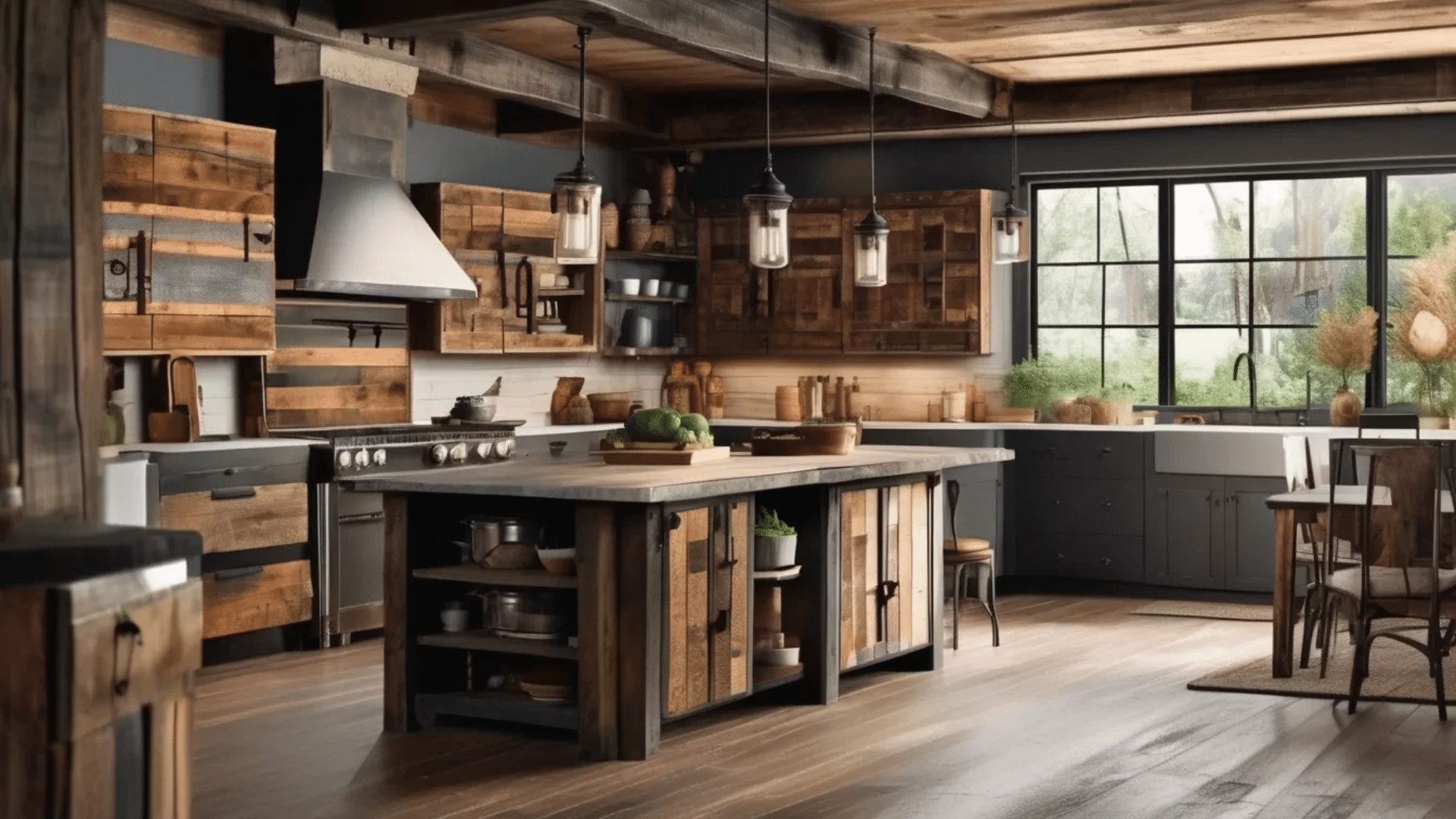
Old barn wood, factory floors, or other salvaged lumber bring history and character to kitchen cabinets. Each piece tells a story through its patina, nail holes, saw marks, and weathering that cannot be authentically replicated in new materials.
Reclaimed wood often comes from old-growth forests that contain trees with tighter grain patterns and higher density than today’s commercially grown lumber. This results in exceptional stability and durability.
Many homeowners value the connection to history that reclaimed wood provides—knowing their cabinets might contain beams from a 200-year-old barn or flooring from a historic factory adds a layer of meaning beyond mere aesthetics.
Pros
Unique character, environmentally friendly, often sturdier than new wood; each kitchen becomes one-of-a-kind; prevents usable wood from entering landfills; dense grain patterns from old-growth timber; naturally aged patina that can’t be replicated; higher resistance to future warping due to complete drying over decades.
Cons
Expensive, may contain lead paint or chemicals, requires sealing; limited availability affects timelines; challenging to work with due to nails, inconsistent dimensions, and hardness; requires specialized knowledge to prepare properly; variations can make achieving a cohesive look difficult; may contain insect damage or other imperfections.
14. Wood Veneer
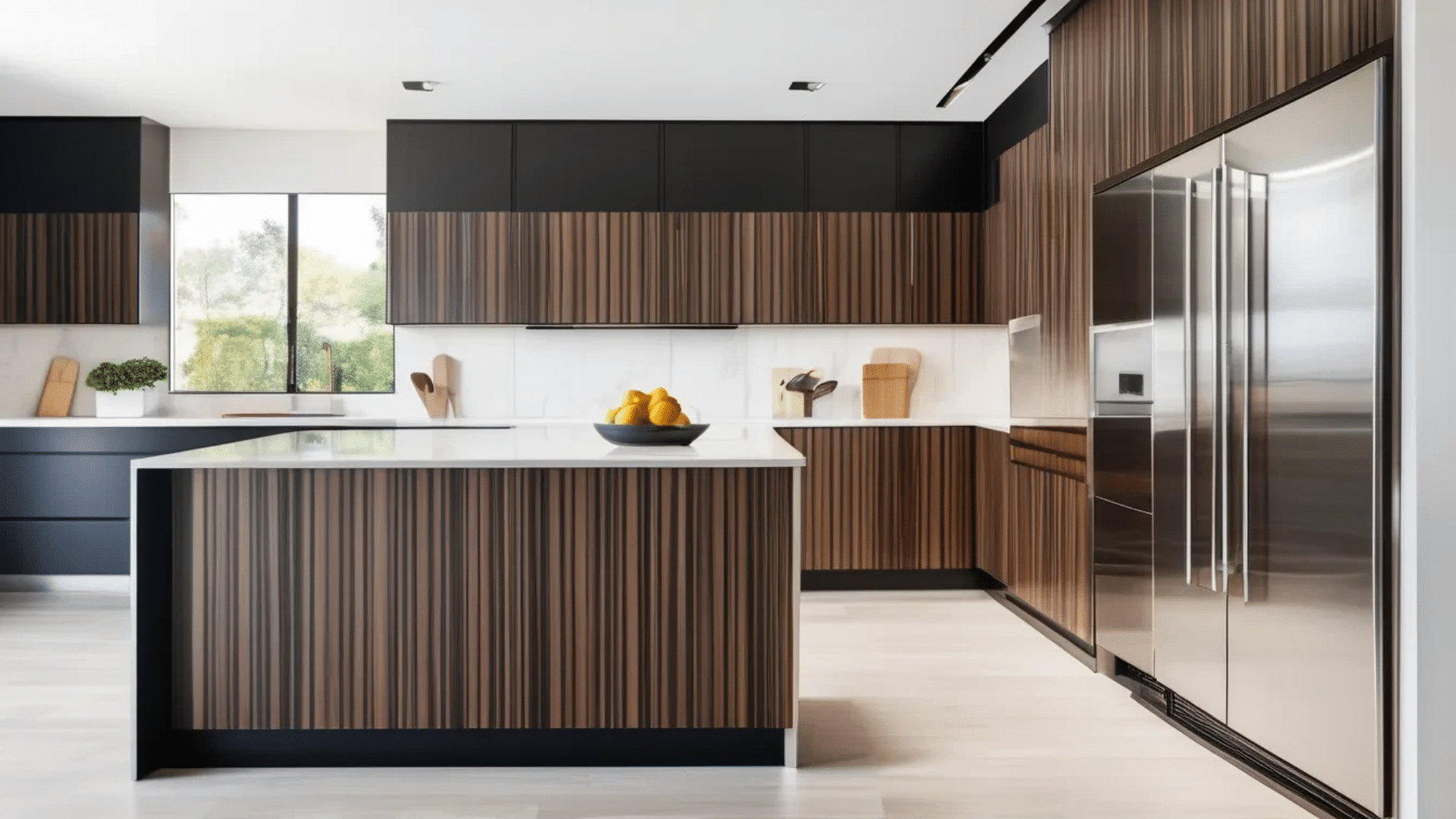
Thin slices of real wood glued to a core material (usually MDF or plywood) offer the look of solid wood at a lower price. Modern veneering techniques create incredibly stable panels that resist the warping and cracking often seen in solid wood doors of the same size.
Veneer allows the use of exotic or rare wood species that would be prohibitively expensive as solid wood. It also enables techniques like book-matching (where grain patterns mirror each other across adjacent doors) and sequential matching (where grain flows continuously across multiple cabinet fronts).
High-end custom cabinetry often uses veneer not just for cost savings but for the aesthetic possibilities and dimensional stability it provides.
Pros
Real wood appearance, more stable than solid wood, less expensive; enables use of exotic or figured woods at reasonable cost; better dimensional stability than solid wood; allows for complex grain patterns and matching; reduces use of precious hardwoods; lighter weight reduces stress on hinges and hardware.
Cons
Can peel over time, limited repair options, damaged by excessive moisture; thin veneer can’t be sanded and refinished multiple times; edges require careful finishing to prevent peeling; quality varies dramatically between manufacturers; cheap veneers may look artificial; UV exposure can cause uneven fading between components.
15. Hybrid Cabinets
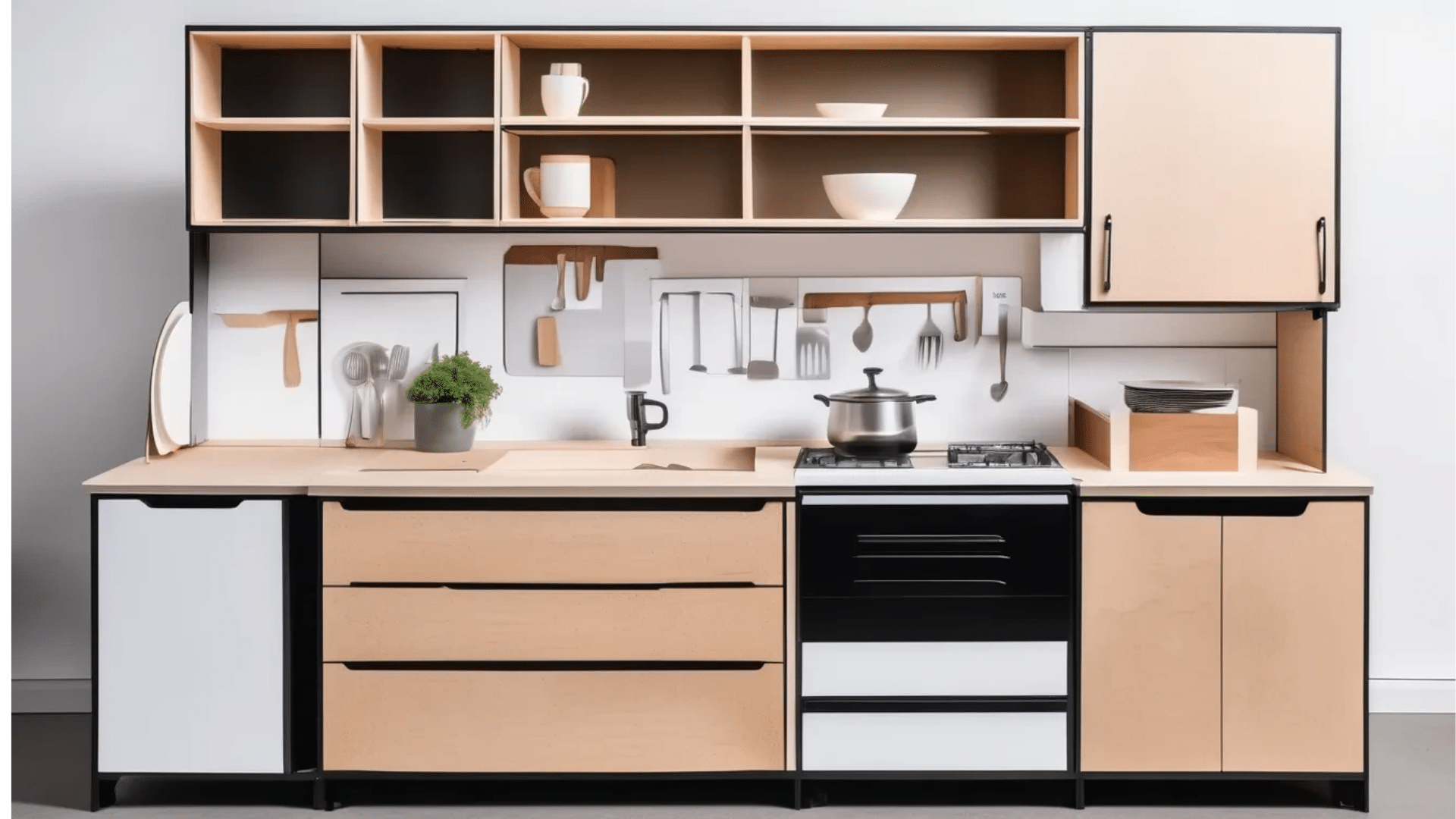
Many modern cabinets combine materials—like plywood boxes with MDF doors—to optimize performance and cost. This strategic approach puts each material where its strengths matter most while minimizing exposure to weaknesses.
A common hybrid configuration uses plywood for structural components like cabinet boxes and shelves while using MDF for doors that will be painted. This provides the structural strength and screw-holding power of plywood where needed while taking advantage of MDF’s smooth, paintable surface for visible components.
Some manufacturers even use different materials within the same component—like solid wood frames with laminate center panels—to balance appearance, performance, and cost.
Pros
Best of both worlds: budget flexibility, customizable performance; optimizes materials for their intended purpose; allows splurging on visible components while economizing on hidden elements; addresses specific environmental concerns; can be tailored to particular usage patterns; combines traditional and modern materials effectively.
Cons
Complexity in manufacturing can raise costs, potential for different wear rates; requires more knowledge to make informed choices; may complicate future repairs or modifications; different expansion rates between materials can cause issues; may void some warranties if not professionally designed; can require specialized installation knowledge.
Comparison Table: Cabinet Materials at a Glance
| Material | Cost | Durability | Moisture Resistance | Maintenance | Weight |
|---|---|---|---|---|---|
| Solid Wood | High | High | Medium | High | Medium |
| Plywood | Medium | High | Medium-High | Low | Medium |
| MDF | Low-Medium | Medium | Low | Low | High |
| Particle Board | Low | Low | Very Low | Low | Medium |
| Melamine | Low | Medium | Medium | Low | Medium |
| Thermofoil | Low-Medium | Medium | High | Low | Medium |
| Laminate | Medium | High | High | Low | Medium |
| Stainless Steel | High | Very High | Very High | Medium | High |
| Acrylic | High | High | High | Medium | Medium |
| Glass Panels | High | Medium | High | High | Medium |
| Bamboo | High | Medium-High | Medium-High | Medium | Light |
| PVC | Medium | High | Very High | Low | Light |
| Reclaimed Wood | High | High | Varies | High | Medium |
| Wood Veneer | Medium | Medium | Low-Medium | Medium | Medium |
| Hybrid | Varies | Varies | Varies | Varies | Varies |
Expert Tips on Matching Materials with Kitchen Styles
I’ve learned that certain materials work better with specific kitchen styles:
- Traditional kitchens look best with solid woods like cherry, maple, or oak with detailed door styles.
- Modern kitchens shine with high-gloss acrylics, laminates, or flat-panel wood designs.
- Farmhouse styles benefit from painted wood or MDF with simple shaker doors.
- Industrial looks pair well with stainless steel or concrete elements combined with wood.
- Coastal kitchens feel right with light-colored woods or painted finishes in blues and whites.
The most successful kitchens often mix materials, such as wood for perimeter cabinets and a different material for the island.
Conclusion
After working with dozens of kitchen cabinet materials over the years, I’ve learned that finding the “perfect” material is a myth. What matters is finding the right match for your specific needs, budget, and lifestyle.
Think about how you actually use your kitchen. Heavy cookers should prioritize heat resistance near appliances. Families with kids might value easy-clean surfaces over natural beauty. Budget-conscious renovators can save by putting quality materials only where they’re most visible.
Remember that cabinets represent about 40% of most kitchen budgets and will impact your daily life for years. Taking the time to understand these material options now will prevent expensive regrets later. Your future self will thank you for the research you do today.
Frequently Asked Questions
What Is the Most Durable Kitchen Cabinet Material for A Busy Family?
High-pressure laminate and acrylic cabinets offer exceptional durability for active households. They resist scratches, stains, and impact while requiring minimal maintenance, making them ideal for families who use their kitchen heavily.
How Do I Balance Quality and Budget when Choosing Cabinet Materials?
Focus on quality materials for visible and high-use areas (like island fronts and sink cabinets) while using more economical options for less visible areas. A hybrid approach—perhaps using plywood boxes with thermofoil doors—can deliver 80% of the quality at 60% of the cost.
Which Cabinet Materials Work Best in Humid Environments Like Coastal Homes?
PVC and stainless steel excel in moist environments as they’re completely impervious to moisture. If you prefer a warmer look, marine-grade plywood with quality waterproof finishes or certain hardwoods like teak offer good humidity resistance while maintaining a natural appearance.
How Can I Make Environmentally Responsible Cabinet Material Choices?
Look beyond just the material to consider manufacturing processes and transportation impact. Local solid woods reduce shipping emissions, while bamboo and reclaimed timber minimize resource depletion. Ask manufacturers about their sustainability certifications and VOC emissions from finishes and adhesives.
What’s the Best Cabinet Material for Someone Who Plans to Sell Their Home Within 5 Years?
Choose materials with broad appeal, like maple, cherry, or white-painted cabinets that won’t quickly look dated. Mid-range options like quality plywood boxes with solid wood doors offer the best return on investment, striking a balance between quality that appraisers recognize and cost that doesn’t exceed neighborhood norms.

